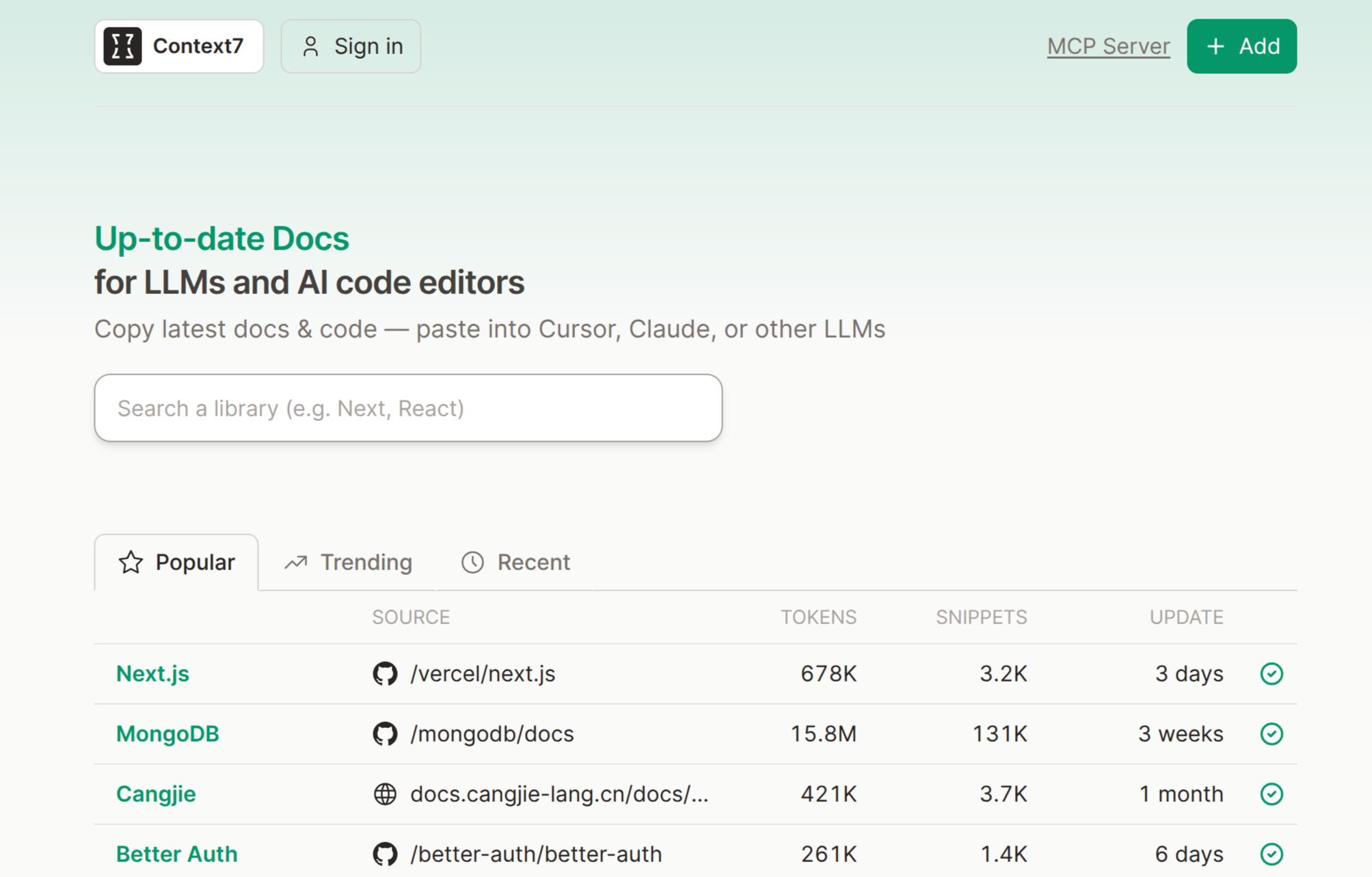
The Problem
You ask Claude for a Next.js middleware. It confidently generates code. You copy it. It doesn’t work. Debugging takes 20 minutes before you realize the API changed in Next.js v14—your Claude was trained on v4 examples.
Or you ask for a Supabase auth component. The code looks perfect. But client.auth.signUp() doesn’t exist anymore—v2 changed the API completely.
Or Redux integration. The patterns work, but they’re 3 years old. Current best practices are totally different now.
The core issue: LLMs have training data cutoffs. Claude’s knowledge stops at April 2024. When libraries update (constantly), the LLM keeps suggesting outdated patterns. It’s not hallucinating—it’s just stale.
This costs developers 30-40% of their time verifying and fixing LLM code instead of writing new code.
The Solution: Context7
Context7 does something simple: inject fresh documentation into Claude’s context window the moment you need it.
Example 1: The Supabase Auth Disaster
Without Context7:
You: "Create a Supabase auth component"
Claude: [generates code with v1 API]
You: [20 minutes debugging]
Result: This API changed in v2With Context7:
You: "Create a Supabase auth component. use context7"
Claude: [fetches current Supabase v2 docs]
Claude: [generates code with correct API]
Result: It just worksYou added use context7. Claude automatically fetches the current Supabase documentation, gets version-specific code examples, and generates code that actually works on first try.
Example 2: The Next.js Middleware That Didn’t Exist
Without Context7:
You: "Create a Next.js middleware with JWT validation"
Claude: [generates using patterns from v13]
Result: Code doesn't run, API changed in v14With Context7:
You: "Create a Next.js middleware with JWT validation. use context7"
Claude: [fetches Next.js v14+ middleware API]
Result: Copy-paste, it worksExample 3: React Hooks Breaking Changes
Without Context7:
You: "Create a form component with useCallback"
Claude: [generates React 18 pattern]
Result: Works now, but deprecated in React 19With Context7:
You: "Create a form component with useCallback. use context7"
Claude: [fetches React v19 docs]
Result: Future-proof code on day oneHow It Actually Works
- You type
use context7in your prompt - Claude calls
resolve-library-idtool → gets matching libraries - Claude picks the right one → calls
get-library-docs - Context7 backend returns current, version-specific documentation
- Documentation gets injected into Claude’s context
- Claude generates code using actual current API
- You get working code in 2-3 seconds
No web search. No latency. Just pre-indexed, instantly available documentation.
Why This Matters
3.8M+ downloads since April 2025. Here’s why Context7 won:
It’s instant — Documentation is pre-indexed, pre-ranked, pre-filtered. No crawling, no searching.
It’s version-aware — Different docs for React v18 vs v19, Next.js v13 vs v14, etc.
It works everywhere — One implementation works with Cursor, VS Code, Cline, Windsurf, Claude Code, Gemini CLI, LM Studio—30+ clients automatically through MCP.
It’s focused — Doesn’t try to do everything. Just does one thing perfectly: get fresh docs to Claude when needed.
Bonus: How to Make It Work Even Better for You
1. Set It as a Rule (Don’t Type It Every Time)
In Cursor (Settings → Rules):
Always use context7 when I ask for:
- Code generation
- Library setup or configuration
- Framework/API documentationNow it runs automatically.
2. Use Specific Library IDs for Speed
Instead of: Create a rate limiter with Express. use context7
Do: Create a rate limiter with Express. use library /express/express
Skips the lookup step. Faster response + fewer API calls.
3. Filter by Topic to Cut Token Waste
Instead of: Create Express middleware. use context7
Do: Create Express middleware. use context7 topic:middleware
Gets only middleware docs. Faster + cheaper + more relevant.
4. Get a Free API Key for 10x Rate Limits
No key = 10 requests/minute. Free key = 100+ requests/minute.
Get it at context7.com/dashboard. Takes 30 seconds.
5. Pin It for Your Team
Add to your project’s .cursor/mcp.json:
{
"mcpServers": {
"context7": {
"url": "https://mcp.context7.com/mcp",
"headers": { "CONTEXT7_API_KEY": "your_key_here" }
}
}
}Or in .windsurfrules:
Always use context7 for any library/framework question.
This ensures all code is current and version-specific.Now your whole team gets working code on first try.
6. Use It for Learning New Libraries
Fastest way to learn React, Next.js, or any framework:
I'm learning React v19. Show me hooks examples. use context7Claude generates code using actual current documentation instead of training data patterns.
The Real Insight
Context7 proves: Don’t compete on search. Compete on relevance.
Everyone can build a documentation search tool. Context7 competes on instant indexing, smart ranking, version intelligence, and token awareness. One problem solved perfectly beats ten problems solved mediocrely. 3.8M+ installs later, that focus won.
Resources
- Get Started: context7.com
- GitHub: upstash/context7
- Directory: Smithery.ai listing
- Community: Upstash Discord
Bottom line: Stop copying outdated patterns from training data. Give Claude fresh docs when it needs them. Context7 does exactly that. 2-3 seconds later, you have working code using the current API. No hallucinations. No debugging. Just code that works.